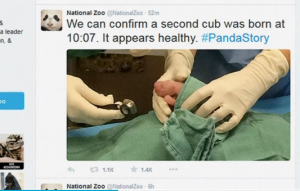
(Reuters) — Giant panda Mei Xiang, a star tourist draw in the U.S. capital, gave birth to a pair of cubs hours apart on Saturday (August 22), the National Zoo said.
Mei Xiang gave birth to her first cub at 5:34 p.m. (2134 GMT) after her water broke about an hour beforehand, zoo officials said. About four and one-half hours later, at 10:07 p.m., a second cub arrived and appeared healthy, the zoo said.
Zoo director Dennis Kelly told a news conference later that zoo officials were being very cautious and “keeping their fingers crossed” after the zoo lost a six-day-old cub in 2012.
The zoo’s Twitter page later said the second cub ‘appears health’.
Zoo officials said Mei Xiang picked up the cub soon after giving birth and is being “a great mother”.
After the second, surprise birth, one cub was placed in an incubator in line with protocol when twins are born.
Mei Xiang previously has given birth to two surviving cubs: Tai Shan in 2005 and Bao Bao in 2013.
Mei Xiang was artificially inseminated on April 26 and 27 with frozen sperm from Hui Hui, a panda in China, and fresh sperm from the National Zoo’s Tian Tian, it said.
Kelly said the gender of the cubs or which of the sperm donors is the father will be determined later. He added that no decision had been made about naming the cubs.
Giant pandas, one of the world’s most endangered species, are known for the striking black and white markings that lend their eyes special resonance for human admirers.
With a very low reproductive rate, particularly in captivity, their natural home is in a few mountain ranges in central China. There are about 1,600 giant pandas known to be living in the wild and some 300 in captivity, mostly in China.






